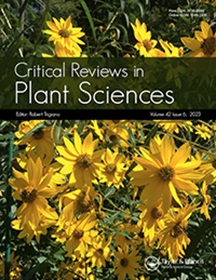粉蚧生态学——非生物因素对其发育和流行病学的影响
IF 6
2区 生物学
Q1 PLANT SCIENCES
引用次数: 1
摘要
摘要粉霉菌是一些最常见和最危险的生物营养化植物病原体。它们攻击一万多种植物,主要分布在温带和亚热带地区。本文评估了最重要的非生物条件对白粉菌的影响,即温度、湿度、光照质量、空气成分(主要是CO2和臭氧浓度)和运动。由于研究最深入的因素,温度和湿度,白粉菌的需求各不相同,这种变化发生在其生命周期的不同阶段。一般来说,温度在13到30之间 °C是它们发育的最佳温度,分生孢子萌发最少,孢子形成是生命周期中受影响最大的部分,较低的边缘温度只会延长潜伏期。水分在其发育中的作用更为难以捉摸;游离水分抑制了大多数粉霉菌分生孢子的扩散和萌发以及菌丝的延伸。然而,为了进一步发育,优选高相对湿度,并且需要游离水来释放和分散子囊孢子。光通过对宿主的影响间接影响病原体。尽管在低光照和黑暗下发芽和附着胞成熟是可能的,但完成疾病周期需要光照。合适的光周期(昼夜交替)有利于最佳发育,例如,持续的光照可以减少感染。CO2浓度的影响是复杂的;有时二氧化碳浓度的增加会导致更严重的疾病,有时影响较小或根本没有。大多数环境因素也会影响宿主,从而间接影响病原体;其他因素(例如紫外线或二氧化碳)主要直接影响病原体。讨论了预测的气候变化对病理系统可能产生影响的假设。本文章由计算机程序翻译,如有差异,请以英文原文为准。
Ecology of Powdery Mildews – Influence of Abiotic Factors on their Development and Epidemiology
Abstract Powdery mildews are some of the most common and dangerous biotrophic plant pathogens. They attack more than 10, 000 plant species, and can be found mainly in temperate and sub-tropical zones. This review evaluates the effects of most important abiotic conditions on powdery mildew namely temperature, humidity, light quality, air composition (mainly CO2 and ozone concentration) and movement. With the most intensively studied factors, temperature and humidity, powdery mildew species vary in their requirements, this variation occurring in different phases of their life cycle. Generally, temperatures between 13 and 30 °C were optimal for their development, with conidial germination being the least and sporulation the most affected part of the life cycle and lower marginal temperatures only prolonging the latent period. The role of moisture in their development is more elusive; free moisture inhibits dispersal and germination of conidia and extension of hyphae of most powdery mildews. However, for further development high relative humidity is preferred and free water is required for release and dispersal of ascospores. Light most affects the pathogen indirectly through its effect on the host. Although germination and appressorial maturation is possible under low illumination and darkness, light is needed for completion of the disease cycle. A suitable photoperiod (alternating day and night) favors optimal development, e.g., continuous light reduces infection. The effect of CO2 concentration is complex; sometimes an increased concentration of CO2 causes more intensive disease, sometimes less or no effect at all. Most environmental factors also affect the host thus affecting the pathogen indirectly; other factors (e.g. UV or CO2) mainly directly affect the pathogen. Hypotheses on the possible effect of predicted climate change on pathosystems are discussed.
求助全文
通过发布文献求助,成功后即可免费获取论文全文。
去求助
来源期刊
CiteScore
12.90
自引率
1.40%
发文量
15
审稿时长
>12 weeks
期刊介绍:
Critical Reviews in Plant Sciences focuses on presenting in-depth and up-to-date reviews of timely and/or cutting-edge subjects in the broad discipline of plant science, ranging from molecular biology/biochemistry through the areas of cell biology, plant pathology and physiology, genetics, classical botany, and ecology, to practical agricultural applications. Articles in the journal provide an up-to-date literature base for researchers and students, pointing the way towards future research needs. The journal is also a significant source of credible, objective information to aid decision makers at all levels.

 求助内容:
求助内容: 应助结果提醒方式:
应助结果提醒方式:


